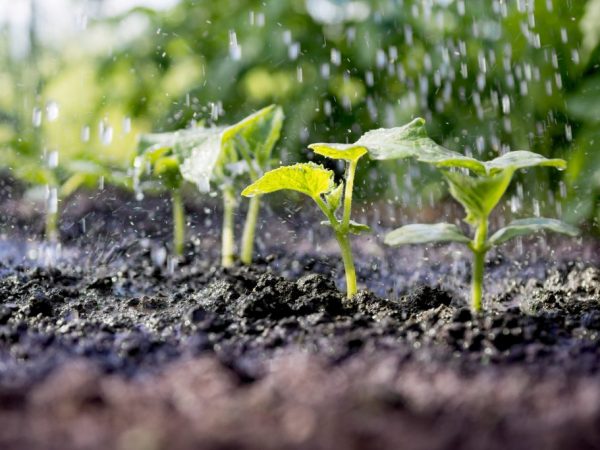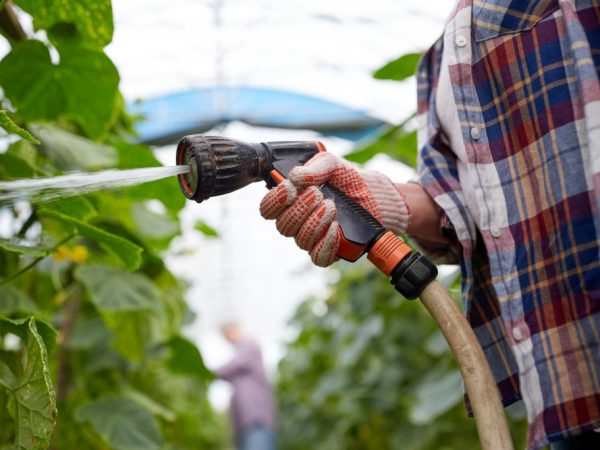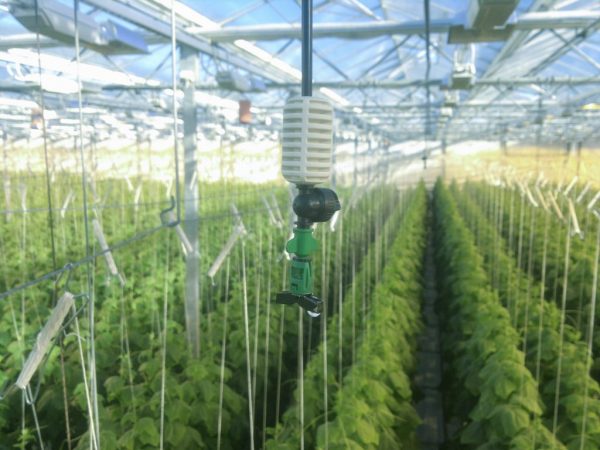How to properly water cucumbers in a polycarbonate greenhouse
Cucumbers belong to a culture that needs water no less than humans. To harvest a good harvest that will delight you with delicious, crispy and healthy cucumbers, you need to know how to water cucumbers in a polycarbonate greenhouse. Watering plays an almost pioneering role in the proper cultivation of this tropical vegetable. The conditions for caring for plantings in open ground and in a polycarbonate greenhouse are slightly different, so you must adhere to some recommendations.

Watering cucumbers in a polycarbonate greenhouse
Why do cucumbers need water?
Cucumber fruits are madly in love with water and moisture, but it is also important that the leaves and roots receive the necessary moisture along with the soil around the plant. By getting the moisture it needs, the plant will look healthy, full of color, and free of painful appearance. Those gardeners who have extensive experience in growing greenhouse crops are advised to irrigate the plantings and walls not only inside the greenhouse, but also outside. Of course, it is best to do such irrigation with a solution of chalk, which is diluted to a liquid state. It is this type of dew that is capable of not evaporating for a long time and will help maintain the necessary humidity.
If your plantings lack moisture, then the fruits may turn yellow and stop developing.
How often to water cucumbers in a polycarbonate greenhouse in the heat or during fruiting? If the plant does not receive enough moisture, then it will die very quickly. Especially in a polycarbonate greenhouse, this applies to crops such as tomatoes or cucumbers. The air temperature in the greenhouse is very high on hot summer days. A plant that can delight with its harvest for a long time, without the necessary watering, reduces the fruiting time at times. Also, with a lack of water and nutrients, diseases can appear. For these reasons alone, watering for greenhouse plantings is so important.
Watering rules
At first glance, it seems that humidification in the open field and in the greenhouse does not make much difference, but this is not the case. In the open field, the plant receives natural ventilation from the root system, as well as from the ground part, and therefore, no matter when it happens, in hot weather or in winter, the soil is always ventilated. In the greenhouse, ventilation must be created independently.
- Watering place. The best option for choosing a watering site is to make grooves. It is best to do them, as close as possible to the plant itself, so that moisture penetrates immediately to the planting and remains in the soil longer. Do not direct the stream of water directly under the root, as this can expose the root system, which in turn will lead to root rot, due to which the plant will die. If, due to negligence, some of the roots are still exposed, then you must immediately sprinkle them with earth and sprinkle the plant.
- Regularity. In this case, we are talking about the same amount of water and approximately equal intervals between irrigations.How often you need to moisturize the plantings depends on their age. Seedlings need to be watered more often than an adult plant.
- Temperature conditions. It is very important to use water at room temperature for humidification. Cold water is very harmful for planting and such watering threatens the appearance of dampness, which means pain.
- Checking the situation. Remember to watch the plants develop. Even with regularity, you can miss something, but if you constantly monitor the situation, you can notice problems and have time to fix them.
Watering methods
If you have a small greenhouse, then naturally, you can water the plantings by hand and it will not be difficult. But imagine how to carry out high-quality and regular watering if there are several dozen greenhouses. Of course, in such cases we are talking about automatic watering.
Manual watering

Use a spray hose for watering
This method is used in a small greenhouse with no more than 4-5 dozen plants. You can water cucumbers from a regular garden watering can, but since the plantings are very fond of being completely doused with water, you must definitely have a hose available for uniform irrigation. It is advisable that the irrigation hose be equipped with a spray nozzle, as a direct, powerful jet of water can damage the root system.
Pros of a manual humidification system
- There are no equipment purchase costs.
- The gardener decides on his own when and how he is best to moisturize his plantings.
- An automatic system can break down, unlike a manual mechanism.
Automatic watering
To facilitate watering in a large greenhouse or multiple greenhouses, there are special automatic systems. They can be made by hand yourself, or you can purchase ready-made ones in certain stores. This is just an amazing invention for any gardener, because in the automatic system there are only advantages for both cucumbers and people.
It is not difficult to create a drip irrigation system and it is best to take care of this in winter, so that during fruiting in the heat you already have everything set up. To do this, it is enough to purchase a hose and make holes along the entire length, about 30 cm from each other. Of course, you can purchase a ready-made special hose that is already marked and ready to use. The cost of automatic wetting of plantings is low and if you need equipment for several years or do not have time to make holes yourself, then buying a special hose will be a great idea.
The water tank is placed on a hill to create a certain pressure. Water is supplied to the tank from a water supply system or a well. If possible, then it is worth making an automatic water supply system, which will significantly save resources and the necessary regularity will be achieved. But even using a drip irrigation system in a polycarbonate greenhouse, you still cannot do without sprinkling or irrigation.
Pros of watering
- System automation.
- Economical water consumption.
- Possibility of calculating the amount of water.
- The system will easily withstand any impacts that are associated with atmospheric phenomena or temperature extremes.
- It is possible to organize the humidification of huge areas.
- Ease of installation and availability of materials.
- No soil washout.
- An increase not only in yield, but also in the taste of the grown fruits.
Organization of watering

Cucumbers need timely watering
It is very important to observe the moisture regime in the greenhouse where the cucumbers are grown. It is impossible to overfill, it is also impossible not to add water, because this will then result in problems with the harvest and soreness or death of all plantings. After the seedlings have been planted in the greenhouse soil and until the cucumbers begin to bloom, it is better to water with sufficient water - about 5 liters per 1 square meter of the greenhouse area.
It is this volume of water that will prevent the plant from growing a large number of extra leaves, but will go to the formation of ovaries. There are times when the fruits, despite proper watering, do not form an ovary, but the deciduous system is actively growing. In such cases, the best option would be to skip moistening the plantings, that is, to dry the soil a little.
It is very important to make regular and sufficient watering at a time when there is an increased formation of ovaries, when the plantings are actively bearing fruit and after harvest.
Dosage of water
The dosage is calculated on the basis of 10-12 liters of water per 1 square meter, every 2-3 days. If the cucumbers have faded, then they should be watered every other day. If the leaves have begun to wither, then it is recommended to water them as soon as you notice it. It is impossible to moisten the plantings with cold water or under the root. It is important to observe the water temperature, otherwise you can lose the entire cucumber crop. When to water - in the morning or in the evening? If you read books on growing cucumbers, you can find information on what is best to moisturize the plantings in the early morning or after the sun has already set.
On especially hot days, when the air temperature exceeds 26 degrees, sprinkling should be carried out along with irrigation.
It is really better to do this in the morning or in the evening, since water procedures during the sun are dangerous because there is a risk of burning the leaves. Sometimes, greenhouse owners do not have the opportunity to devote enough time to their plants and give them proper watering. Why is this happening? The fact is that garden or vegetable garden plots can be located away from the immediate place of residence, which is very inconvenient. This is one of the most important reasons why people install drip irrigation systems in their greenhouses. Of course, this type of hydration is considered the most favorable for your plantings.
Useful tips for gardeners
Growing any kind of vegetable in a greenhouse has its pros and cons. Of course, the greenhouse protects plants from the external environment, bad weather, the temperature in the greenhouse is much higher, which means that growth will be better. But there are also some downsides. It is imperative to monitor the humidity, humidification must always be carried out, regardless of the weather outside. Sometimes, the leaves of greenhouse plantings may turn yellow. This is not a huge problem and can be easily solved. Feed on time with special fertilizers, which are very convenient to apply along with watering. Also, do not leave the harvest of fruits on plants for a long time, because they greatly overload the delicate stems, which also entails negative consequences.
The value of the material for the greenhouse
It seems like what's the difference from what the greenhouse is made and how it relates to soil moisture and planting. But in reality, everything matters. The temperature regime, humidity level, and hence the amount of watering depend on the material from which the greenhouse is made. If the soil dries up, then naturally more water will be needed. Polycarbonate has shown itself to be very good as a material for the manufacture of greenhouses. It is durable, flexible, which means that the greenhouse can be shaped in different ways. Polycarbonate is resistant to mechanical damage and, above all, has an attractive appearance.
Of course, there are also some downsides. But there are few of them and this is a significant and costly cost of the material and its flammability. But observing security measures, you can not worry about it. And the high cost is justified by the long shelf life and an excellent harvest of vegetables that can be grown in a greenhouse all year round. In a polycarbonate greenhouse, you can grow a crop of delicious, crispy, healthy fruits. Caring for them is easy and simple if you make your work easier by installing a drip humidification system. There is nothing difficult or impossible, the main thing is to air the greenhouse in time and moisturize the planting. Only in this case, you can get a plentiful and healthy harvest of cucumbers.


